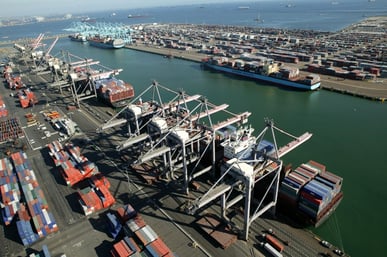January 11, 2017 – Oslo, Norway - Xeneta, the leading global benchmarking and market intelligence platform for containerized ocean freight, is forecasting further uncertainty for the global container shipping market in 2017. Although rates have risen significantly from the historic lows of early 2016, giving battered shipowners some reprieve, structural problems continue to undermine stability, while macro-economic and political factors are casting long shadows on the horizon.
2016 was a tumultuous year for carriers, defined by low rates, overcapacity and the subsequent collapse of Hanjin. However, the final months of the year saw generally higher short-term rates, with the market average price for 40’ containers on the world’s number one trade route – Far East Asia to North American main ports – climbing from a low of 1164 USD in April to 1716 USD by the close of 2016.
The same rates on the number two route – Far East Asia to North Europe – climbed from lows of 791 USD to 1878 USD by the end of the year.
“Prices rose from Q3 into Q4 before flattening out a little,” comments Xeneta CEO Patrik Berglund, “but the carriers’ position improved significantly from the dire situation they found themselves in early 2016. That said, it had to.
“With the majority of carriers losing money hand over fist last year, the industry simply wasn’t sustainable. And that’s bad news for shippers, as well as the shipowners, as they need optimal reliability in their supply chain. Stability is what all parties desire – built on a foundation of fair rates – but that still looks elusive as we head into 2017.
“However,” he adds, “profit is still the Holy Grail and all parties need to chase the pennies. Whoever achieves the lowest cost base per TEU, while at the same time optimising their agreements on every single transaction, will emerge as the victors in this ultra competitive landscape. A few dollars here and there on every container can add up to millions in profit for the biggest players.”
Xeneta crowd sources real-time global shipping data from major international businesses to give users unparalleled insight into the complex container shipping market. In the past few months it has grown its community from 600 to more than 700 companies, feeding in data for over 160,000 port-to-port pairings and more than 23 million contracted rates (up from 17 million in Q3 last year).
So far in 2017, this community reports that the long-term rates that have been locked are high in relation to 2016 – actually closing in on 2015 levels - but the trend is to put the typical January negotiations (when European shippers secure agreements) on hold.
“There’s such uncertainty in the market that shippers are stalling coming to the table, they’re unsure of where they stand,” Berglund states. “The fact that the carriers are prepared to accept this delay shows they believe they’re in a strong position – that prices will continue to develop over the coming months, allowing them to lock in higher rates when talks finally begin. This is a clear indication of positive sentiment from their side.
“So, at the moment, it looks like a seller’s market and if the carriers hold firm then shippers will eventually have to accept higher rates. However, the fact of the matter is there remains a structural overcapacity of containers-to-cargo. That puts carriers in a weak position and creates huge competition for business. So it only takes one or two carriers to drop rates and chase market share and, lo and behold, prices fall again. The volatility will return.”
He adds: “In 2016, some major players stated a belief that liner-shipping has become a commoditized business. This isn’t the case, yet. We strongly believe containers are a commodity and that basing rates on an index would provide the stability the industry sorely needs, but work needs to be done to achieve this. Namely, the right tools have to be in place and an industry consensus established. Then we might see real progress.”
As it stands, further uncertainty is provided by an unpredictable economic and geo-political situation, as Berglund explains.
“With the looming inauguration of Donald Trump, the continued fallout from the Brexit vote and a rising tide of more ‘insular’ political thinking, the outlook for global trade is, well, interesting,” he notes. “Carriers will be paying close attention to developments.
“At the same time newbuild orders have plummeted and shipyards are seeking to stay in business by offering vessels at not-even-break-even prices. If this entices owners to place orders then we have the prospect of additional overcapacity and further downward pressure on rates. That is not what the sector needs right now.”
Despite these warnings, Berglund maintains the situation has improved for carriers, but that both they and shippers need to stay on their toes: “As we saw last year, especially with Hanjin, the market can literally transform overnight. While it is looking promising for carriers right now, that can change rapidly, so all parties should try and follow market trends as closely as possible.
“A real-time overview of rates allows for accurate benchmarking against the market, better decision making and negotiations, and greater value services. In such a volatile segment this kind of intelligence isn’t just a nice to have, it’s a must.”


-1.jpg)

